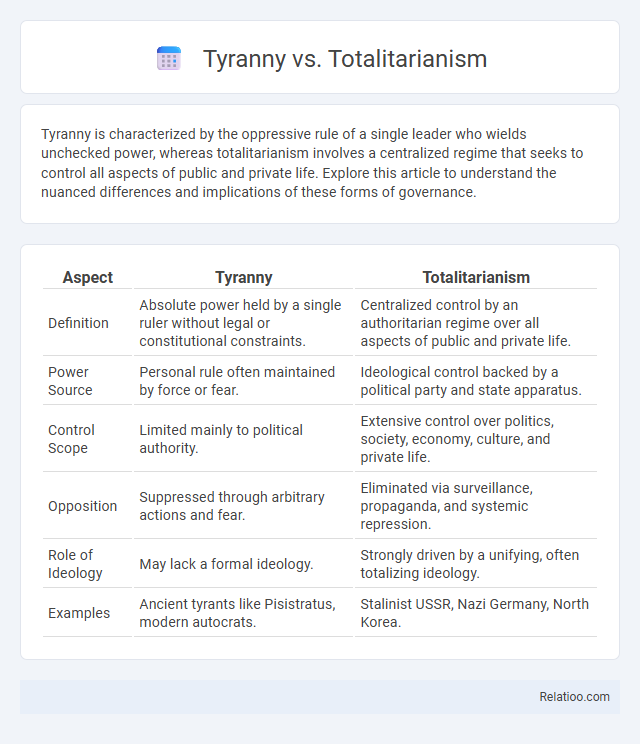Tyranny is characterized by the oppressive rule of a single leader who wields unchecked power, whereas totalitarianism involves a centralized regime that seeks to control all aspects of public and private life. Explore this article to understand the nuanced differences and implications of these forms of governance.
Table of Comparison
| Aspect | Tyranny | Totalitarianism |
|---|---|---|
| Definition | Absolute power held by a single ruler without legal or constitutional constraints. | Centralized control by an authoritarian regime over all aspects of public and private life. |
| Power Source | Personal rule often maintained by force or fear. | Ideological control backed by a political party and state apparatus. |
| Control Scope | Limited mainly to political authority. | Extensive control over politics, society, economy, culture, and private life. |
| Opposition | Suppressed through arbitrary actions and fear. | Eliminated via surveillance, propaganda, and systemic repression. |
| Role of Ideology | May lack a formal ideology. | Strongly driven by a unifying, often totalizing ideology. |
| Examples | Ancient tyrants like Pisistratus, modern autocrats. | Stalinist USSR, Nazi Germany, North Korea. |
Introduction to Tyranny and Totalitarianism
Tyranny refers to oppressive rule by a single ruler who wields absolute power without legal or constitutional restraints, often maintaining control through fear and arbitrary decisions. Totalitarianism is an extreme form of tyranny characterized by centralized authority that seeks to control every aspect of public and private life, employing ideology, propaganda, and surveillance to enforce conformity. Both systems suppress political dissent and individual freedoms but differ in scope, with totalitarian regimes exerting broader societal control than traditional tyrannies.
Defining Tyranny: Characteristics and Origins
Tyranny is a form of oppressive rule characterized by the concentration of power in the hands of a single ruler who exercises authority without legal or moral constraints. Originating from ancient Greek political theory, tyranny is marked by arbitrary governance, suppression of dissent, and the absence of checks and balances. Understanding the characteristics of tyranny helps you recognize how such regimes prioritize personal control over institutions, differing from totalitarianism's ideological dominance and broader societal control.
Totalitarianism Explained: Key Features
Totalitarianism is characterized by absolute centralized control where the state directs all aspects of public and private life, often through propaganda, surveillance, and political repression. It features a single-party system led by a dictator who enforces ideological conformity and eliminates political opposition. Unlike general tyranny, totalitarian regimes exert complete dominance over social, economic, and cultural institutions to maintain power and control.
Historical Examples of Tyranny
Historical examples of tyranny include the rule of King Louis XVI in pre-revolutionary France, where absolute power led to widespread oppression and economic crisis. Tyranny differs from totalitarianism, evident in regimes like Nazi Germany under Hitler, which exercised total control over political, social, and cultural life. Your understanding of these systems benefits from analyzing these distinct forms of authoritarian rule and their impacts on societies.
Totalitarian Regimes in History
Totalitarian regimes in history, such as Nazi Germany under Adolf Hitler and the Soviet Union under Joseph Stalin, are characterized by centralized control where the state seeks to regulate nearly every aspect of public and private life. Unlike traditional tyranny, where power is concentrated in a single ruler often for personal gain, totalitarianism employs extensive propaganda, surveillance, and state-controlled institutions to enforce ideological conformity and suppress dissent across society. These regimes utilize total control mechanisms, including secret police forces and state-run media, to maintain absolute authority and eliminate political opposition.
Methods of Control: Tyrannical vs Totalitarian Rule
Tyrannical rule employs coercion, fear, and arbitrary use of power often centralized in a single ruler to maintain control, relying heavily on personal loyalty and repression. Totalitarian regimes implement pervasive surveillance, propaganda, and control over all aspects of life including economy, education, and private beliefs to ensure absolute obedience and ideological conformity. While tyranny is typically limited to political oppression, totalitarianism extends its methods of control into social and cultural spheres to enforce uniformity and suppress dissent at all levels.
Impact on Individual Freedoms
Tyranny severely restricts individual freedoms through arbitrary and oppressive rule, often limiting political dissent and civil rights. Totalitarianism extends beyond tyranny by controlling nearly all aspects of life, including thought, expression, and private behavior, employing surveillance, propaganda, and state terror. Both systems eradicate democratic institutions, but totalitarian regimes achieve deeper social control, leaving virtually no space for personal autonomy or privacy.
The Role of Ideology in Totalitarianism
Totalitarianism is characterized by a pervasive and rigid ideology that dictates every aspect of society, binding the state and its citizens under a unifying set of beliefs. Unlike tyranny, which centers on the oppressive rule of a single individual without necessarily an all-encompassing ideological framework, totalitarian regimes use ideology to justify and legitimize absolute control over political, social, and cultural life. Understanding the role of ideology in totalitarianism helps you recognize how these regimes manipulate beliefs to maintain power and suppress dissent.
Resistance and Consequences
Resistance against tyranny often involves localized uprisings and civil disobedience, whereas opposition to totalitarianism typically requires coordinated, large-scale movements due to its pervasive control over society. The consequences of tyranny usually entail political repression and economic instability, while totalitarian regimes inflict widespread loss of personal freedoms and systematic state violence. Your ability to challenge either system depends on understanding their distinct mechanisms of control and the severe repercussions faced by dissenters.
Modern Implications and Lessons Learned
Tyranny and totalitarianism both represent forms of oppressive governance, with tyranny typically characterized by the arbitrary rule of a single ruler, while totalitarianism involves an all-encompassing control over public and private life by the state. Modern implications highlight the dangers of unchecked political power leading to erosion of individual freedoms, surveillance, and suppression of dissent, emphasizing the importance of constitutional safeguards and active civic engagement. Your awareness of these lessons helps protect democratic institutions and prevent the rise of authoritarian regimes in contemporary society.

Infographic: Tyranny vs Totalitarianism
 relatioo.com
relatioo.com